 Researchers have developed what could be the bone implant material of the future: an airy, foamlike substance that can be injected into the body and provide scaffolding for the growth of new bone.
Researchers have developed what could be the bone implant material of the future: an airy, foamlike substance that can be injected into the body and provide scaffolding for the growth of new bone.
Monday, March 18, 2019
From foam to bone: Plant nanocellulose can pave the way for healthy bone implants
 Researchers have developed what could be the bone implant material of the future: an airy, foamlike substance that can be injected into the body and provide scaffolding for the growth of new bone.
Researchers have developed what could be the bone implant material of the future: an airy, foamlike substance that can be injected into the body and provide scaffolding for the growth of new bone.
Heading towards a tsunami of light
 Scientists have proposed a way to create a completely new source of radiation. Ultra-intense light pulses consist of the motion of a single wave and can be described as a tsunami of light. The strong wave can be used to study interactions between matter and light in a unique way.
Scientists have proposed a way to create a completely new source of radiation. Ultra-intense light pulses consist of the motion of a single wave and can be described as a tsunami of light. The strong wave can be used to study interactions between matter and light in a unique way.
Semimetals are high conductors
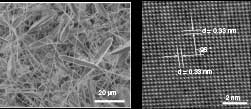 Researchers have measured high conductivity in very thin layers of niobium arsenide, a type of material called a Weyl semimetal. The material has about three times the conductivity of copper at room temperature.
Researchers have measured high conductivity in very thin layers of niobium arsenide, a type of material called a Weyl semimetal. The material has about three times the conductivity of copper at room temperature.
Supercrystal: A hidden phase of matter created by a burst of light
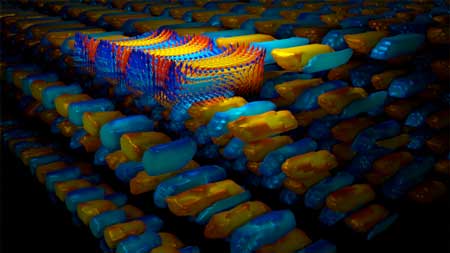 This is one of the first examples of a new state of matter with long-term stability transfigured by the energy from a sub-pico-second laser pulse.
This is one of the first examples of a new state of matter with long-term stability transfigured by the energy from a sub-pico-second laser pulse.
Researchers discover new material to help power electronics
 Scientists have discovered a way to simplify how electronic devices use electrons - using a material that can serve dual roles in electronics, where historically multiple materials have been necessary.
Scientists have discovered a way to simplify how electronic devices use electrons - using a material that can serve dual roles in electronics, where historically multiple materials have been necessary.
Long-distance quantum information exchange - success at the nanoscale
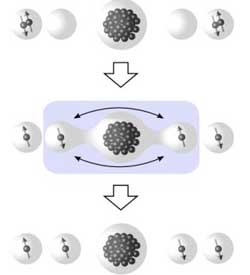 Researchers have realized the swap of electron spins between distant quantum dots. The discovery brings us a step closer to future applications of quantum information, as the tiny dots have to leave enough room on the microchip for delicate control electrodes.
Researchers have realized the swap of electron spins between distant quantum dots. The discovery brings us a step closer to future applications of quantum information, as the tiny dots have to leave enough room on the microchip for delicate control electrodes.
Molecular motors run in unison in a metal-organic framework
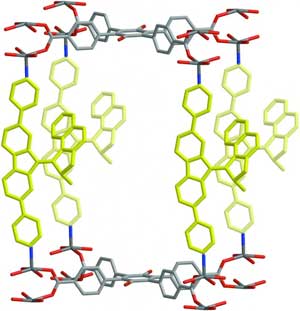 Organic chemists have succeeded in integrating numerous unidirectional light-driven rotary motors into a metal-organic framework.
Organic chemists have succeeded in integrating numerous unidirectional light-driven rotary motors into a metal-organic framework.
On-chip, electronically tunable frequency comb
 Researchers have developed an integrated, on-chip frequency comb that is efficient, stable and highly controllable with microwaves.
Researchers have developed an integrated, on-chip frequency comb that is efficient, stable and highly controllable with microwaves.
A ground-breaking chemical protocol: on-surface synthesis of acene polymers
 A new chemical protocol introduces the on-surface design of anthracene-based polymers with a small electronic bandgap, interesting for organic optoelectronics.
A new chemical protocol introduces the on-surface design of anthracene-based polymers with a small electronic bandgap, interesting for organic optoelectronics.
Researchers create water-resistant electronic skin with self-healing abilities
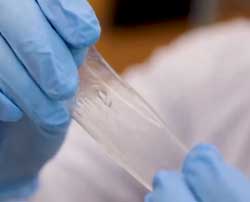 The skin-like material is conductive, transparent, and can repair itself either in air or when submerged in water.
The skin-like material is conductive, transparent, and can repair itself either in air or when submerged in water.
Motion control at the nanoscale
 Pysicists have designed a bipedal nanowalker that can change its walking manner and direction by adjusting the length of its stride.
Pysicists have designed a bipedal nanowalker that can change its walking manner and direction by adjusting the length of its stride.
Subscribe to:
Comments (Atom)
